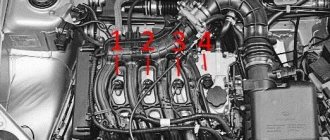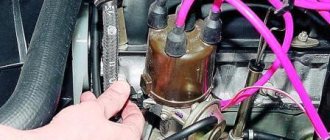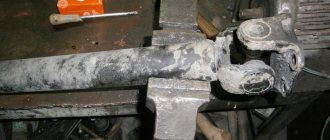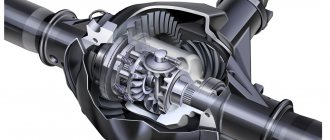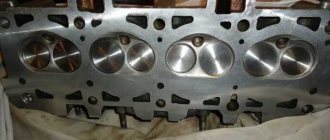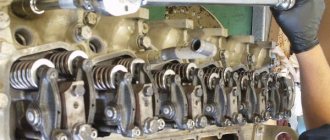Many car owners do not even think about the order of operation of the engine cylinders of their car, limiting themselves only to knowing their number. Such information is not needed to drive a vehicle and most drivers do not see the point in studying technical details.
Understanding the process turns out to be useful for setting the ignition, replacing the timing belt and other types of work during independent adjustment or repair, when it is not possible to seek help from a service station.
How many cylinders are there in an engine?
Throughout the history of mechanical engineering, engineers and designers have pursued one goal - obtaining maximum efficiency from the engine. To achieve this, more and more powerful engines were developed with varying numbers of cylinders - from 1 to 16, and attempts were made and continue to be made to place “horsepower” in the smallest possible volume of engine compartment space.
Single-cylinder engines are installed in mini-tractors, low-power mopeds and motorcycles. For more powerful motor vehicles, a 4-stroke 2-cylinder engine is required. Modern three-cylinder internal combustion engines are mainly installed on small cars and are equipped with a turbine to increase power.
Important
4-cylinder engines have been the most popular in the automotive industry for over a hundred years. Almost all modern passenger cars are equipped with them.
Five-cylinder engines are not so popular. Previously, they were widely used by such giants of the global automotive industry as Volkswagen, Volvo, Audi
Six and 8 cylinder engines are also popular. Despite the worldwide practice of reducing the number of cylinders due to turbocharging, such internal combustion engines are gradually losing their positions. In recent years, many automakers have been abandoning eight-cylinder engines in favor of 6-cylinder engines, this is especially noticeable in the market for powerful passenger cars.
ICEs with 7 or 9 cylinders are used in aircraft. They are not used in the automotive industry, with rare exceptions - in tuned models. 10- and 11-cylinder engines are also very rare in the automotive industry. You can admire the “ten” in the Audi R8 sports car.
The 12-cylinder engine was used more widely in the auto industry. But due to tightening environmental regulations, their production is inexorably declining.
There are also internal combustion engines with 14, 16, 18, 20, 24, 28, 32 and 64 cylinders. They are a combination of several engines with fewer cylinders and are practically not used in automobile production.
Possible causes of failure
During the operation of the internal combustion engine, various malfunctions are possible. To detect them, you should perform the following sequence of actions:
- First you need to start the car. The engine should idle. At this time, you should listen to what sounds are coming from the exhaust pipe. If you hear regular popping noises, then one of the cylinders is faulty. The cause may be faulty spark plugs and lack of spark. The malfunction can also be caused by a large amount of incoming air or insufficient compression in the cylinder.
- It is necessary to inspect the candles. If there is carbon deposits, moisture or oxidation, you need to clean it. Check the gap between the electrodes, which should be 0.8 - 0.9 mm.
- Replace all spark plugs, regardless of their appearance and vehicle mileage.
- If there are irregular emissions, you need to inspect the high-voltage wires. There should be no traces of oxidation on their tips, and the insulation should not be damaged. If defects are found, the wire should be replaced.
Wires connecting to the coil
- The gas distributor cap should be inspected. There should be no soot or cracks on it. The carbon contact should be checked for damage and wear.
- The rotor needs to be inspected. It must be solid and have no signs of burnout. All parts with defects must be replaced.
- The pressure in the cylinders is allowed to be no lower than 1.1 MPa, and the compression difference should not exceed 0.1 MPa. If the indicators do not correspond, engine repair is necessary.
If after the above steps the problems remain, then you need to contact a service station to undergo a more accurate diagnosis of the VAZ 2109 engine and adjust the ignition system on the stand.
Valves, their purpose, operation of a 4-stroke engine
The engine valve is both a part and the last link of the gas distribution mechanism. It is a spring-loaded element that, when at rest, blocks the inlet or outlet. When the camshaft rotates, the cam located on it presses on the valve and lowers it, thereby opening the corresponding hole
At least two valves are installed on each cylinder. More expensive engine models have four of them. In most cases, the number of valves is even, their purpose is to open different groups of holes: some are intended for inlet, the other for exhaust.
Intake valves open the passage for a new portion of the air-fuel mixture entering the cylinder, and in engines with direct fuel injection, a volume of air. This process occurs at the moment the piston performs intake (moving down from the top “dead” point after removing combustion products).
Exhaust valves work on the same principle, but perform a different function. They are designed to remove exhaust gases into the exhaust manifold. The operating cycle of a 4 cylinder engine is a sequence of four processes called the "duty cycle". Let's consider it using the example of a gasoline four-stroke internal combustion engine installed in most passenger cars.
1. Inlet.
In the combustion chamber, energy conversion begins and the first stage is the combustion reaction of the air-fuel mixture. In this case, the piston moves down from top dead center, a vacuum occurs and fuel is injected. At this time, the inlet valve is open, the outlet valve is in the closed position. In injection engines, fuel is supplied by a nozzle.
2. Compression.
After the combustion chamber is filled with a mixture of gasoline vapor and air, the piston moves to the lower position during rotational movements of the crankshaft. The intake valve gradually closes, but the exhaust valve remains closed.
3. Working stroke.
The third stage of the work cycle is the most important. It is here that the energy of the burning fuel turns into mechanical energy, driving the crankshaft.
Even during the compression process, when the piston is located at the top point, the fuel mixture is ignited by a spark from the spark plug. The fuel charge burns quickly, and the resulting gases are under maximum pressure in the small space of the combustion chamber.
As the piston moves downward, the gases expand rapidly, releasing energy. At this stage, acceleration acceleration is transmitted to the crankshaft. At all other strokes of the cycle, the engine only receives energy from the crankshaft without producing it.
4. Release.
This is the last stroke of the work cycle. On it, gases that have completed useful work are released from the cylinder, freeing up space for the next portion of the air-fuel mixture to enter.
At this stage, the gases are under pressure significantly higher than atmospheric pressure. The crankshaft moves the piston through the connecting rod to top dead center. The exhaust valve opens and gases are pushed out through the exhaust system.
The operating cycle of diesel engines is somewhat different from gasoline engines. At the inlet, only air is sucked in, and fuel is injected into the combustion chamber by the fuel pump after compressing the air mass. Diesel fuel ignites when it comes into contact with compressed air.
A little about internal combustion engines
Knowledge about the structure and operation of a car will be a big plus for any car enthusiast. This is especially true for the engine - the most important element and heart of the iron horse. ICE has a lot of varieties - starting from the type of fuel and ending with small nuances unique to each car.
But the essence of the work is approximately the same:
Thanks to the sequential operation of the cylinders, the crankshaft is in constant motion, generating torque. The more cylinders, the easier and faster the crankshaft will rotate. So a diagram emerged, familiar even to schoolchildren who do not understand hardware - more cylinders - more powerful engine.
4-cylinder engine, most common
As mentioned above, 4 cylinder engines are the most common in the automotive industry. Based on the number of pairs of valves per cylinder, they are divided into two groups.
8-valve engines are installed mainly on models in the low price group. They have one intake and exhaust valve for each cylinder - a total of 8 valves.
The peculiarity of such internal combustion engines is the use of a single camshaft that controls the injection and exhaust gas removal systems. To operate it, a chain or belt mechanism is used. Such a system is easy to repair and maintain, and due to the simplicity of the design, the cost of the car is significantly reduced.
In more expensive car models, each engine cylinder has two pairs of intake and exhaust valves - a total of 16 valves. Such systems use two camshafts, the operation of which requires a complex gas distribution mechanism.
The use of two intake valves provides more fuel per stroke, which increases engine power and efficiency. Also, thanks to the presence of two exhaust valves, fuel consumption is reduced.
What does the numbering depend on?
Numbers are given to cylinders depending on various factors.
In most cases, the list of factors is as follows: Thus, depending on the various options, the cylinders themselves may have different locations. For example, this could be a direction in a row in a vertical order.
Thus, depending on each of these features, the numbering of the cylinders is completely different. And to determine the number of a particular cylinder of your car, you will have to take into account each of the options.
Thus, the numbering order of engine cylinders is not a simple matter.
Next, we will look at what the cylinder numbers for the most common car brands may be, which will also greatly help you in studying this aspect.
The order of operation of the cylinders and why this is so
There are two types of 4 cylinder engines:
- in-line;
- Opposite.
The crankshaft layout is the same, but the order of operation of the cylinders is different. This is due to differences in the design of the gas distribution mechanism, ignition system, and also depends on the angles between the crankshaft cranks.
The in-line 4-cylinder engine operates in a 1-3-4-2 operating order. It is used in the vast majority of cars - both diesel and gasoline, from Lada to Mercedes. Here, cylinders located on opposite journals of the crankshaft operate sequentially. The order of operation of the cylinders of a 4-cylinder opposed internal combustion engine is organized in a different sequence: 1-3-2-4 or 1-4-2-3.
In this case, the pistons reach top dead center on both sides at the same time. “Opposed” cars can be seen on almost all Subaru models, with the exception of some small cars sold on the domestic market.
What about now?
Contrary to popular belief, 8-cylinder engines are installed not only in luxury foreign cars, but also in ordinary tractors, trucks and construction equipment. As with weaker engines, the most balanced type is the in-line engine type. In other words, when all the cylinders are located in a row. They were used to equip the most expensive cars for a long time. This design was especially appreciated in America. However, the record holders here are the Germans, who highly value the balance and reliability of the in-line engine.
But even they, over time, had to switch to V-twin engines. The reason is simple and banal - the eight-cylinder Python simply did not fit in the standard engine compartment of modern cars.
Preparing the car
The machine being manipulated is placed on a flat surface. The driver's cabin reclines and locks. The upper part of the gas distribution mechanism is dismantled and the pump is turned off.
KamAZ 43118:
Devices:
- Keys: open-end for 13, ring for 14;
- Screwdrivers;
- Steel rod;
- Set of measuring plates.
Fixing the main chamber piston at the top
- Check the fixation force of the camera heads;
- Move the flywheel stop device down;
- Remove the flywheel housing protection plate;
- Insert the steel rod into the hole in the flywheel, turn clockwise until the product stops. Position – beginning of mixture injection (cylinder one).
Flywheel retainer, KamAZ engine:
Setting gaps
- Rotate the flywheel (2 holes – 60°, each 30°);
- Adjust the spacing of the first pair of cameras (1st and 5th). Using a 14 ring wrench, loosen the nuts
- adjusting screws. Use the 0.3 plate to adjust the intake valve, and the 0.4 plate to adjust the exhaust valve.
- Fix the nut, force 33-41 Nm.
- Adjust the spacing in chambers one through eight.
Setting up KamAZ 740, 6520, 5511 valves and other modifications:
- 180 degrees – 4th, 2nd;
- 180 degrees – 6th, 3rd;
- 180 degrees – 7th, 8th.
Adjusting clearances KamAZ:
Repair of car components
The cylinder block structure consists of parts that operate in aggressive conditions, and therefore are often subject to breakage and wear.
Restoring an engine cylinder block consists of the following operations:
| No. of works | Operations Performed | Technical equipment. |
| 1 | Grinding the surface of the crankshaft bearing stop | Vertical milling machine |
| 2 | Replacing worn camshaft bushings | Press-fitting device |
| 3 | Repairing threaded holes | Drilled equipment, set of drills, lantern, die |
| 4 | Pressing out the fastening pins | Special press |
| 5 | Boring, repair of engine CPG cover. Adjustment by plane, installation by holes | Vertical milling machine |
| 6 | Processing the body for sleeves and boring for thrust edges | Vertical boring machine |
| 7 | Boring of main bearing seats | Horizontal boring machine |
| 8 | Gas-thermal spraying on treated bearing seats | Special technological equipment |
| 9 | Double-circuit boring of the body | Honing machine |
| 10 | Washing the engine and cleaning the oil channels | Equipment for jet washing of parts. |
| 11 | Painting the block | Spray gun. Compressor. |
Repair of the engine cylinder block ends with a control inspection on the test plate. Using a feeler gauge and indicator devices, the installation rigidity and alignment of the mounting components in the engine cylinder block are checked. After the engine cylinder body has been restored, a leak test is carried out.
Cylinder head assembly
Repair of the engine cylinder head is performed for the following reasons:
- broken drive shaft belt;
- cylinder head deformation due to overheating;
- duration of service lines;
- incorrect assembly after repair of the unit cylinder block.
Defects of engine cylinder head parts
You can restore defects using the following steps:
- grinding valves;
- the cylinder head is polished;
- gaskets and belts are being replaced;
- Bushings and valve seats are bored.
Post-repair control
After troubleshooting, the cylinder head is painted and the pressure in the cylinder is checked.
An indicator that indicates the effective performance of engine cylinder block parts is compression.
What is the pressure in the cylinders of different brands of engines?
The final stage, painting
Before painting the engine cylinder block, it is necessary to carry out preparatory operations, which consist of the following points:
- cleaning parts from adhering dirt, oil, carbon deposits;
- removing traces of corrosion (if any);
- grinding contaminated threaded channels.
The cylinder head is painted separately so that the air and oil passages do not become clogged.
The operation of the cylinders is not dependent on painting, but it is important to protect the block from contamination.
How to paint the engine depends on financial capabilities. Online stores offer a wide variety of products that can be used to treat the surface of parts after repairing the engine block and cylinders.




